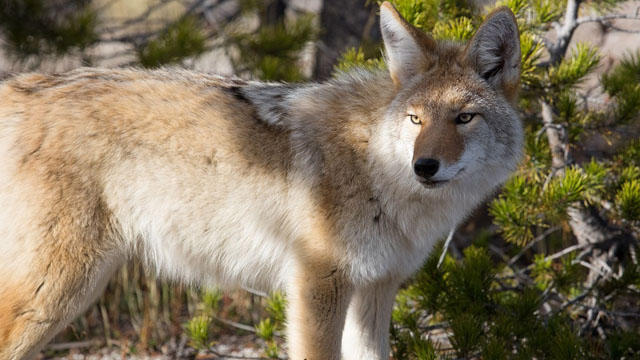What to do When You See a Coyote in Brampton
Published December 24, 2018 at 12:09 pm

There are hundreds of coyote sightings in Brampton every year, and, though rarely, there have been some reports of coyote attacks over the years.
There are hundreds of coyote sightings in Brampton every year, and, though rarely, there have been some reports of coyote attacks over the years. It’s no secret that we live with wildlife in Brampton, and there are ways to avoid conflict and live in harmony.
Many Brampton homes back onto ravines that coyotes frequent, and there are warnings posted in several parks about coyotes in the area, like White Spruce Park and along the Etobicoke Creek trail. In 2014 alone, Brampton woman Jasmine Bajaj was reportedly attacked by a coyote in her own driveway, and there were three reports of coyotes attacking dogs.
While a certain degree of hysteria hits when coyote attacks occur, it is important to be aware that attacks on humans are very rare and that you absolutely can take steps to safeguard your pets.
It’s also crucial to remember that coyotes do serve a purpose.
According to animal services across the region, coyotes are an important part of the urban ecosystem because they control rodent and rabbit populations (sad for the tiny rodents and adorable bunnies). They tend to hunt after dusk and before dawn, so you’re unlikely to encounter one while you’re out and about with your dog during the day.
While people are often concerned that a coyote might attack a human (namely a child or small adult), the risk is low.
Typically, coyotes shy away from humans, but are known to watch and follow people from afar out of natural curiosity. If you display an aggressive action while being watched by a coyote (such as yelling or moving quickly), there’s a good chance it will become frightened and leave.
When it comes to urban coyotes, the chief concern almost always revolves around house pets. Shy or not, coyotes will hunt pets who are off-leash or otherwise unattended outdoors.
So, what do you do if you encounter a coyote in Brampton?
According to Brampton Animal Services, it’s best to stay calm and wait for the animal to retreat. If you give into your instinct to turn and run from the petite but quick-footed beasty, it will likely chase you and your pet (much like a domestic dog would). If the animal continues to approach you, it’s best to stand tall and waive your arms to appear as large as possible.
You can also clap, shout, make startling movements or throw objects in the coyote’s general direction. If you behave aggressively and erratically, the coyote will likely run off. That said, do not approach, run from, or attempt to chase the animal – that is extremely dangerous and may provoke an attack. You can also startle your furry stalker by opening an umbrella, using a flashlight (you should always carry a flashlight during nighttime walks in unlit areas) or activating an alarm or other loud noise on your phone. If you try to scare the animal away but still feel you are at imminent risk of attack, call 911.
If you’re walking in an area that’s known to have coyote activity, Brampton Animal Services also suggests you avoid walking alone and carry and audible alarm and flashlight or umbrella that can be used to scare coyotes off.
If you see a coyote that appears injured or ill and you want to help, do not attempt to touch or move the animal yourself. You can report distressed coyotes or those displaying abnormal behavious like exploring a home or building far from their natural habitat by calling 905-458-5800.
All that said, you’ve probably read about savage coyote attacks on people and are still worried about your own safety.
Fortunately, an attack should not be high on your list of concerns. According to the Humane Society of The United States, you are more likely to be killed an errant golf ball or flying champagne cork than a coyote. Most attacks occur when humans are feeding coyotes and when people are intervening in an attack on a smaller animal (often — and most tragically — their pet). Sometimes, people are bitten by coyotes that they have cornered (which is why you should never, ever attempt to attack the animal). On rare occasions, rabid coyotes bite people.
In terms of fatal attacks, they are almost unheard of. There are currently only two known incidents of people being killed by coyotes. In the 1980s, a child was killed by an animal in Southern California and in 2009, a young Toronto woman was fatally attacked in Nova Scotia.
At this point, absolutely no reputable organization is recommending an urban coyote cull (mass killing) because they’re not a significant threat to city residents.
Since it’s unlikely that you will be your local coyote’s next victim, it’s important to focus on protecting your pets.
According to the Ontario Ministry of Natural Resources and Forestry, you can safeguard your home by installing flashing lights, motion sensors and noise makers and erecting a tall fence (although you’ll have to ensure its height doesn’t violate local bylaws).
According to Brampton Animal Services, you should ensure your yard is enclosed by a solid fence at least 1.8 metres tall, properly store and maintain garbage containers that might attract small rodents (which are a food source for coyotes), remove any pet food that’s left outside, avoid composting meat products, and use motion-sensitive lights so that they are less attractive for coyotes and other nocturnal wildlife.
If you have a dog or cat that you are worried about, you should keep them indoors at night and ensure your yard is free from pet waste (coyotes are attracted to dog feces). You should also spay and neuter your dogs because coyotes may try to mate with them otherwise.
You can also keep your pets safe by keeping your dog on a short leash and discouraging it from chasing wildlife. You should also inspect your yard for coyotes before letting your pet outside — especially at night.
Though it’s highly unlikely your child will be at risk, in order to protect your children from coyotes, Brampton Animal Services advises not to leave children unattended, and educate them to not approach or harass any wildlife or unfamiliar domestic pets.
All in all, be vigilant but not paranoid. It is highly unlikely that a coyote will attack you or your children and you can take common sense steps to ensure your pets are safe.
Be safe and continue to enjoy those dusk, dawn, or nighttime walks.
For more information, click here.
INsauga's Editorial Standards and Policies